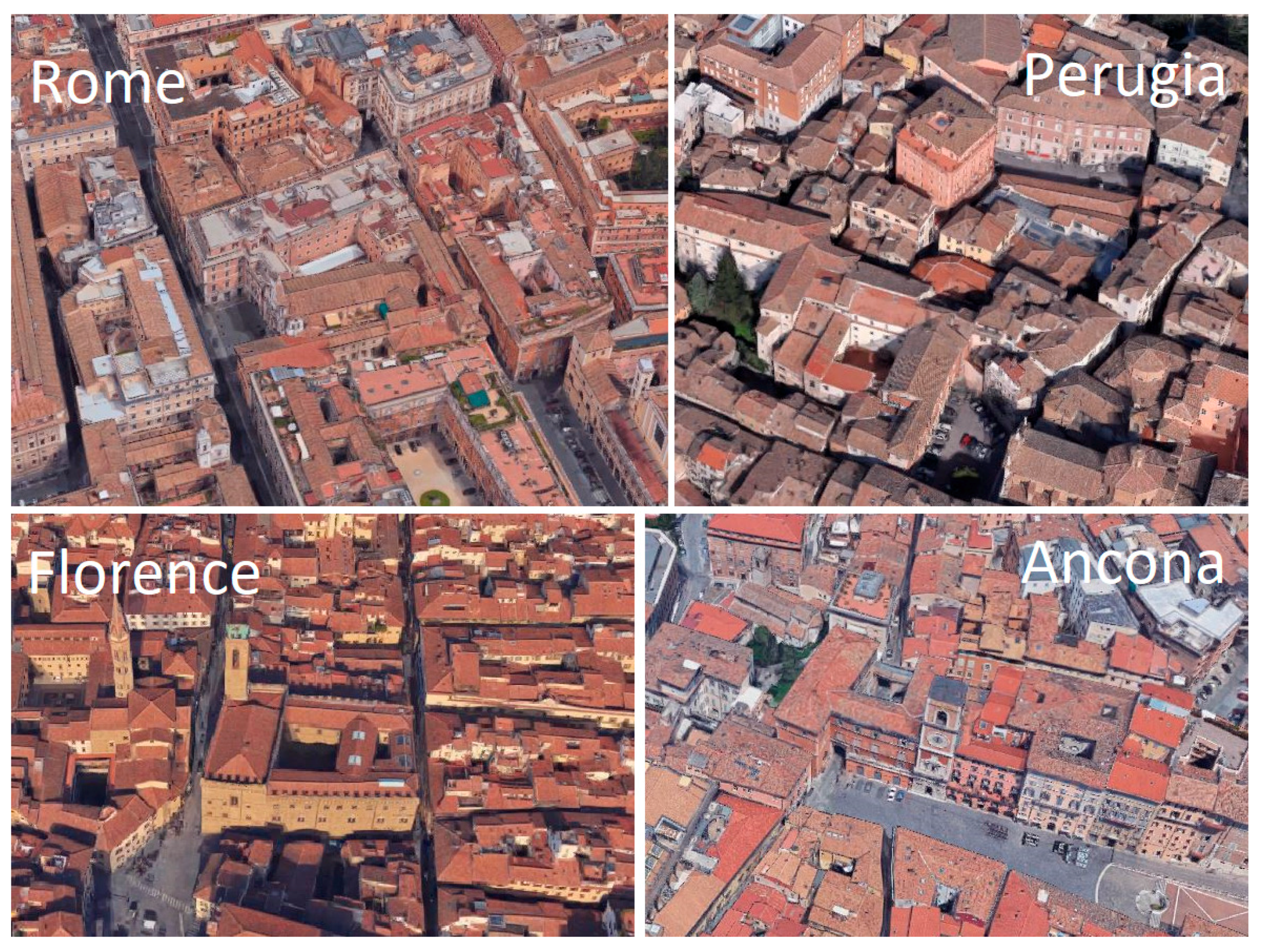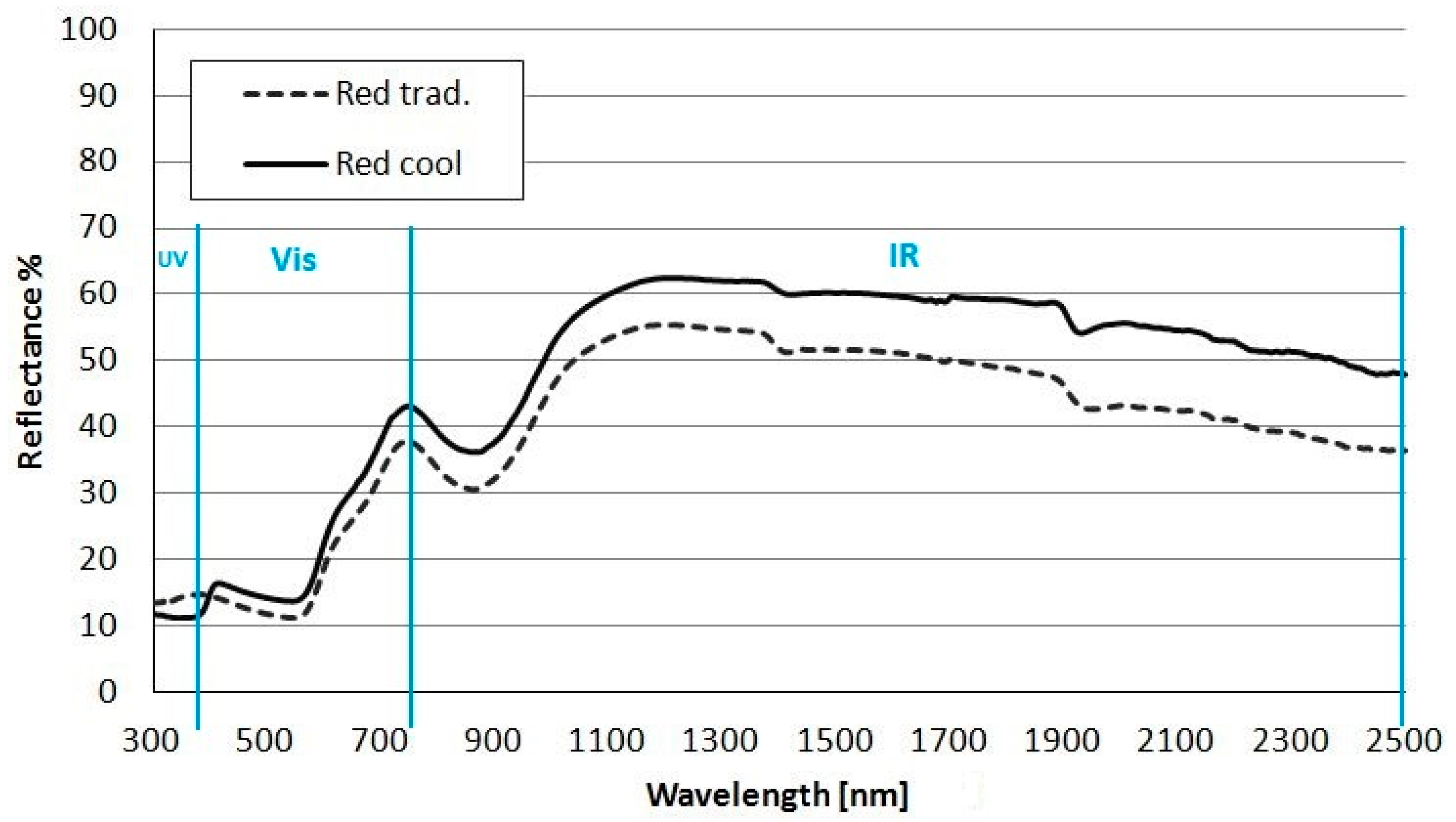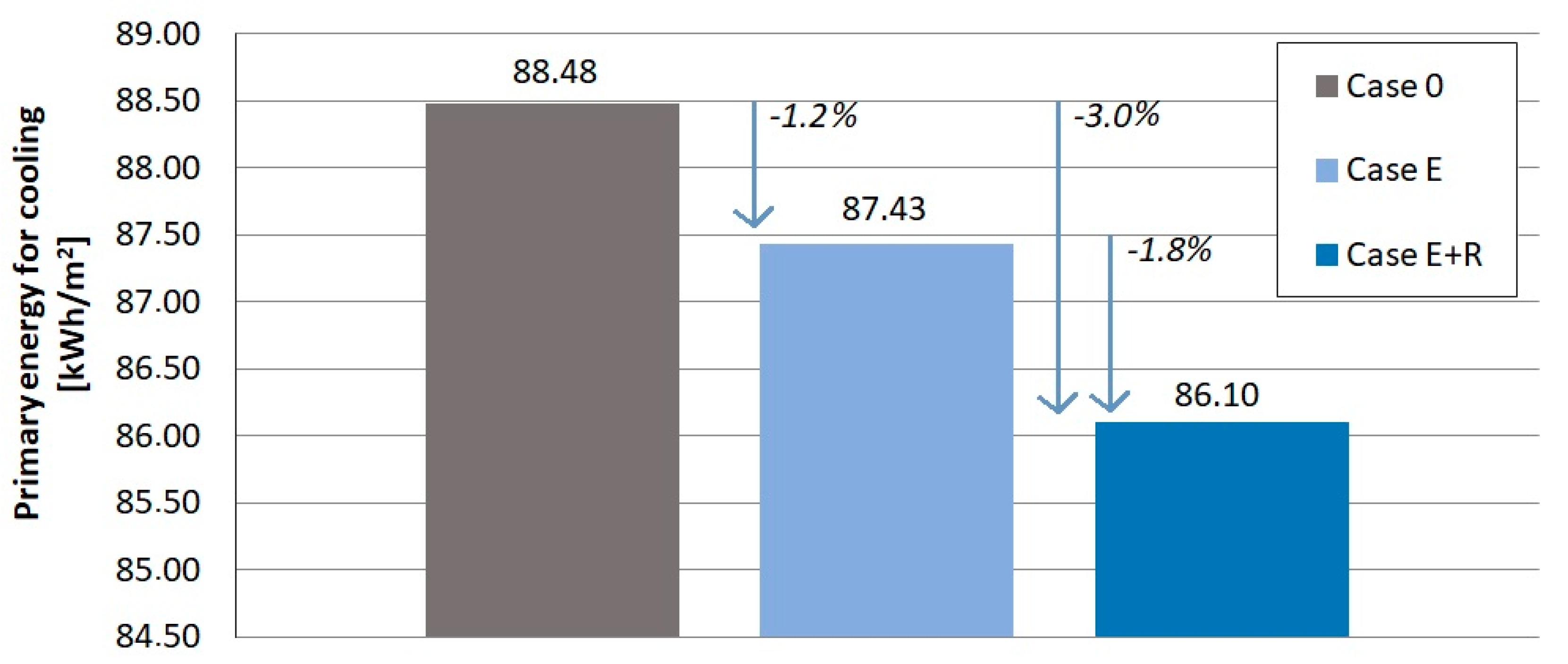On Innovative Cool-Colored Materials for Building Envelopes: Balancing the Architectural Appearance and the Thermal-Energy Performance in Historical Districts
Abstract
:1. Introduction
2. Method
2.1. Materials Implementation and Characterization
2.2. Case Study Building Selection and Dynamic Simulation
3. Results and Discussion
3.1. Materials’ Characterization
3.2. Thermal-Energy Analyses
4. Discussion and Conclusions
Acknowledgments
Author Contributions
Conflicts of Interest
References
- Mazzarella, L. Energy retrofit of historic and existing buildings. The legislative and regulatory point of view. Energy Build. 2015, 95, 23–31. [Google Scholar] [CrossRef]
- Presidenza Repubblica Italiana. Decreto Legislativo 22 Gennaio 2004. 2004. Available online: http://presidenza.governo.it/USRI/confessioni/norme/D_lgs_42-2004.pdf (accessed on 9 December 2017).
- Filippi, M. Remarks on the green retrofitting of historic buildings in Italy. Energy Build. 2015, 95, 15–22. [Google Scholar] [CrossRef]
- EBC. Final Report Annex 53. Total Energy Use in Buildings Analysis and Evaluation Methods. 2013. Available online: http://www.iea-ebc.org/fileadmin/user_upload/docs/SR/EBC_SR_Annex53.pdf (accessed on 9 December 2017).
- Berardi, U. A cross-country comparison of the building energy consumptions and their trends. Resour. Conserv. Recycl. 2017, 123, 230–241. [Google Scholar] [CrossRef]
- Cabeza, L.F.; Palacios, A.; Serrano, S.; Ürge-Vorsatz, D.; Barreneche, C. Comparison of past projections of global and regional primary and final energy consumption with historical data. Renew. Sustain. Energy Rev. 2018, 82, 681–688. [Google Scholar] [CrossRef]
- Directive 2002/91/EC of The European Parliament Andof the Council of 16 December 2002 on the Energy Performance of Buildings. 2002. Available online: https://www.researchgate.net/publication/284627208_Directive_200291EC_of_the_European_Parliament_and_of_the_Council_on_the_energy_performance_of_buildings (accessed on 13 December 2017).
- Directive 2010/31/EU of The European Parliament and of the Council of 19 May 2010 on the Energy Performance of Buildings (Recast). 2010. Available online: http://eur-lex.europa.eu/LexUriServ/LexUriServ.do?uri=OJ:L:2010:153:0013:0035:EN:PDF (accessed on 13 December 2017).
- Cappa, F.; Del Sette, F.; Hayes, D.; Rosso, F. How to deliver open sustainable innovation: An integrated approach for a sustainable marketable product. Sustainability 2016, 8, 1341. [Google Scholar] [CrossRef]
- Manzano-Agugliaro, F.; Montoya, F.G.; Sabio-Ortega, A.; García-Cruz, A. Review of bioclimatic architecture strategies for achieving thermal comfort. Renew. Sustain. Energy Rev. 2015, 49, 736–755. [Google Scholar] [CrossRef]
- De Gracia, A.; Navarro, L.; Coma, J.; Serrano, S.; Romaní, J.; Pérez, G.; Cabeza, L.F. Experimental set-up for testing active and passive systems for energy savings in buildings—Lessons learnt. Renew. Sustain. Energy Rev. 2018, 82, 1014–1026. [Google Scholar] [CrossRef]
- Webb, A.L. Energy retrofits in historic and traditional buildings: A review of problems and methods. Renew. Sustain. Energy Rev. 2017, 77, 748–759. [Google Scholar] [CrossRef]
- Li, Q.; Sun, X.; Chen, C.; Yang, X. Characterizing the household energy consumption in heritage Nanjing Tulou buildings, China: A comparative field survey study. Energy Build. 2012, 49, 317–326. [Google Scholar] [CrossRef]
- De Santoli, L.; Mancini, F.; Rossetti, S.; Nastasi, B. Energy and system renovation plan for Galleria Borghese, Rome. Energy Build. 2016, 129, 549–562. [Google Scholar] [CrossRef]
- Nastasi, B. Renewable hydrogen potential for low-carbon retrofit of the building stocks. Energy Procedia 2015, 82, 944–949. [Google Scholar] [CrossRef]
- Ascione, F.; de Rossi, F.; Vanoli, G.P. Energy retrofit of historical buildings: Theoretical and experimental investigations for the modelling of reliable performance scenarios. Energy Build. 2011, 43, 1925–1936. [Google Scholar] [CrossRef]
- De Santoli, L.; Mancini, F.; Nastasi, B.; Ridolfi, S. Energy retrofitting of dwellings from the 40’s in Borgata Trullo—Rome. Energy Procedia 2017, 133, 281–289. [Google Scholar] [CrossRef]
- Ciulla, G.; Galatioto, A.; Ricciu, R. Energy and economic analysis and feasibility of retrofit actions in Italian residential historical buildings. Energy Build. 2016, 128, 649–659. [Google Scholar] [CrossRef]
- Pisello, A.L.; Petrozzi, A.; Castaldo, V.L.; Cotana, F. On an innovative integrated technique for energy refurbishment of historical buildings: Thermal-energy, economic and environmental analysis of a case study. Appl. Energy 2014, 162, 1313–1322. [Google Scholar] [CrossRef]
- Salata, F.; Alippi, C.; Tarsitano, A.; Golasi, I.; Coppi, M. A first approach to natural thermoventilation of residential buildings through ventilation chimneys supplied by solar ponds. Sustainsbility 2015, 7, 9649–9663. [Google Scholar] [CrossRef]
- Coppi, M.; Quintino, A.; Salata, F. Numerical study of a vertical channel heated from below to enhance natural ventilation in a residential building. Int. J. Vent. 2013, 12, 41–49. [Google Scholar] [CrossRef]
- Gratia, E.; De Herde, A. Natural ventilation in a double-skin facade. Energy Build. 2004, 36, 137–146. [Google Scholar] [CrossRef]
- Pisello, A.L.; Castaldo, V.L.; Rosso, F.; Piselli, C.; Ferrero, M.; Cotana, F. Traditional and Innovative Materials for Energy Efficiency in Buildings. Key Eng. Mater. 2016, 678, 14–34. [Google Scholar] [CrossRef]
- Pisello, A.L.; Rosso, F. Natural Materials for Thermal Insulation and Passive Cooling Application. Key Eng. Mater. 2015, 666, 1–16. [Google Scholar] [CrossRef]
- Hee, W.J.; Alghoul, M.A.; Bakhtyar, B.; Elayeb, O.; Shameri, M.A.; Alrubaih, M.S.; Sopian, K. The role of window glazing on daylighting and energy saving in buildings. Renew. Sustain. Energy Rev. 2015, 42, 323–343. [Google Scholar] [CrossRef]
- Rosso, F.; Pisello, A.; Jin, W.; Ghandehari, M.; Cotana, F.; Ferrero, M. Cool Marble Building Envelopes: The Effect of Aging on Energy Performance and Aesthetics. Sustainability 2016, 8, 753. [Google Scholar] [CrossRef]
- Doya, M.; Bozonnet, E.; Allard, F. Experimental measurement of cool facades’ performance in a dense urban environment. Energy Build. 2012, 55, 42–50. [Google Scholar] [CrossRef]
- Salata, F.; Golasi, I.; di Salvatore, M.; de Lieto Vollaro, A. Energy and reliability optimization of a system that combines daylighting and artificial sources. A case study carried out in academic buildings. Appl. Energy 2016, 169, 250–266. [Google Scholar] [CrossRef]
- Coma, J.; Pérez, G.; Solé, C.; Castell, A.; Cabeza, L.F. Thermal assessment of extensive green roofs as passive tool for energy savings in buildings. Renew. Energy 2016, 85, 1106–1115. [Google Scholar] [CrossRef]
- Runsheng, T.; Etzion, Y.; Erell, E. Experimental studies on a novel roof pond configuration for the cooling of buildings. Renew. Energy 2003, 28, 1513–1522. [Google Scholar] [CrossRef]
- Pérez, G.; Rincón, L.; Vila, A.; González, J.M.; Cabeza, L.F. Behaviour of green facades in Mediterranean Continental climate. Energy Convers. Manag. 2011, 52, 1861–1867. [Google Scholar] [CrossRef]
- Pisello, A.L.; Cotana, F. The thermal effect of an innovative cool roof on residential buildings in Italy: Results from two years of continuous monitoring. Energy Build. 2014, 69, 154–164. [Google Scholar] [CrossRef]
- Pisello, A.L.; Cotana, F.; Nicolini, A.; Brinchi, L. Development of clay tile coatings for steep-sloped cool roofs. Energies 2013, 6, 3637–3653. [Google Scholar] [CrossRef]
- Synnefa, A.; Santamouris, M.; Apostolakis, K. On the development, optical properties and thermal performance of cool colored coatings for the urban environment. Sol. Energy 2007, 81, 488–497. [Google Scholar] [CrossRef]
- Synnefa, A.; Karlessi, T.; Gaitani, N.; Santamouris, M.; Assimakopoulos, D.N.; Papakatsikas, C. Experimental testing of cool colored thin layer asphalt and estimation of its potential to improve the urban microclimate. Build. Environ. 2011, 46, 38–44. [Google Scholar] [CrossRef]
- Uemoto, K.L.; Sato, N.M.N.; John, V.M. Estimating thermal performance of cool colored paints. Energy Build. 2010, 42, 17–22. [Google Scholar] [CrossRef]
- Levinson, R.; Akbari, H.; Berdahl, P.; Wood, K.; Skilton, W.; Petersheim, J. A novel technique for the production of cool colored concrete tile and asphalt shingle roofing products. Sol. Energy Mater. Sol. Cells 2010, 94, 946–954. [Google Scholar] [CrossRef]
- Ihara, T.; Jelle, B.P.; Gao, T.; Gustavsen, A. Accelerated aging of treated aluminum for use as a cool colored material for facades. Energy Build. 2016, 112, 184–197. [Google Scholar] [CrossRef]
- Rosso, F.; Pisello, A.L.; Castaldo, V.L.; Cotana, F.; Ferrero, M. Smart cool mortar for passive cooling of historical and existing buildings: Experimental analysis and dynamic simulation. Energy Procedia 2017, 134, 536–544. [Google Scholar] [CrossRef]
- Rosso, F.; Pisello, A.L.; Castaldo, V.L.; Fabiani, C.; Cotana, F.; Ferrero, M.; Jin, W. New cool concrete for building envelopes and urban paving: Optics-energy and thermal assessment in dynamic conditions. Energy Build. 2017, 151, 381–392. [Google Scholar] [CrossRef]
- Castaldo, V.L.; Rosso, F.; Golasi, I.; Piselli, C.; Salata, F.; Pisello, A.L.; Ferrero, M.; Cotana, F.; de Lieto Vollaro, A. Thermal comfort in the historical urban canyon: The effect of innovative materials. Energy Procedia 2017, 134, 151–160. [Google Scholar] [CrossRef]
- Song, J.; Qin, J.; Qu, J.; Song, Z.; Zhang, W.; Xue, X.; Shi, Y.; Zhang, T.; Ji, W.; Zhang, R.; et al. The effects of particle size distribution on the optical properties of titanium dioxide rutile pigments and their applications in cool non-white coatings. Sol. Energy Mater. Sol. Cells 2014, 130, 42–50. [Google Scholar] [CrossRef]
- Huntsman Huntsman, Altiris Pigments. Available online: http://www.huntsman.com/altiris/a/Home (accessed on 4 February 2016).
- Doulos, L.; Santamouris, M.; Livada, I. Passive cooling of outdoor urban spaces. The role of materials. Sol. Energy 2004, 77, 231–249. [Google Scholar] [CrossRef]
- Rosso, F.; Pisello, A.L.; Cotana, F.; Ferrero, M. On the thermal and visual pedestrians’ perception about cool natural stones for urban paving: A field survey in summer conditions. Build. Environ. 2016, 107, 198–214. [Google Scholar] [CrossRef]
- Salata, F.; Golasi, I.; Vollaro, A.D.L.; Vollaro, R.D.L. How High Albedo and Traditional Buildings’ Materials and Vegetation Affect the Quality of Urban Microclimate. A Case Study. Energy Build. 2015, 99, 32–49. [Google Scholar] [CrossRef]
- Salata, F.; Golasi, I.; de Lieto Vollaro, E.; Bisegna, F.; Nardecchia, F.; Coppi, M.; Gugliermetti, F.; de Lieto Vollaro, A. Evaluation of different urban microclimate mitigation strategies through a PMV analysis. Sustainability 2015, 7, 9012–9030. [Google Scholar] [CrossRef]
- American Society of Testing Materials. ASTM E903—12 Standard Test Method for Solar Absorptance, Reflectance, and Transmittance of Materials Using Integrating Spheres; American Society of Testing Materials: West Conshohocken, PA, USA, 1996; Available online: http://www.astm.org/Standards/E903.htm (accessed on 7 December 2017).
- International Organization for Standardization. ISO 22007–2:2008—Plastics—Determination of Thermal Conductivity and Thermal Diffusivity—Part 2: Transient Plane Heat Source (Hot Disc) Method. Available online: http://www.iso.org/iso/catalogue_detail.htm?csnumber=40683 (accessed on 4 February 2016).
- American Society for Testing Materials. ASTM C1371-04a(2010)e1 Standard Test Method for Determination of Emittance of Materials Near Room Temperature Using Portable Emissometers; American Society for Testing Materials: West Conshohocken, PA, USA, 2010. [Google Scholar]
- Belardi, P. Palazzo Gallenga Stuart di Perugia. 2008. Available online: http://www.academia.edu/1779999/Il_Palazzo_Gallenga_Stuart_di_Perugia (accessed on 13 December 2017).
- Design Builder. Available online: http://www.designbuilder.co.uk/ (accessed on 9 December 2017).
- Rosso, F.; Pisello, A.; Cotana, F.; Ferrero, M. Integrated Thermal-Energy Analysis of Innovative Translucent White Marble for Building Envelope Application. Sustainability 2014, 6, 5439–5462. [Google Scholar] [CrossRef]
- Piselli, C.; Saffari, M.; de Gracia, A.; Pisello, A.L.; Cotana, F.; Cabeza, L.F. Optimization of roof solar reflectance under different climate conditions, occupancy, building configuration and energy systems. Energy Build. 2017, 151, 81–97. [Google Scholar] [CrossRef]
- Santamouris, M.; Gaitani, N.; Spanou, A.; Saliari, M.; Giannopoulou, K.; Vasilakopoulou, K.; Kardomateas, T. Using cool paving materials to improve microclimate of urban areas—Design realization and results of the flisvos project. Build. Environ. 2012, 53, 128–136. [Google Scholar] [CrossRef] [Green Version]
- Rosso, F.; Jin, W.; Pisello, A.L.; Ferrero, M.; Ghandehari, M. Translucent marbles for building envelope applications: Weathering effects on surface lightness and finishing when exposed to simulated acid rain. Constr. Build. Mater. 2016, 108, 146–153. [Google Scholar] [CrossRef]







| Scenarios | Passive Solution | Optimized Elements |
|---|---|---|
| Case 0 | - | - |
| Case E | Cool-colored mortar | Envelope |
| Case E+R | Cool-colored mortar and cool-colored clay tiles | Envelope and roof |
© 2017 by the authors. Licensee MDPI, Basel, Switzerland. This article is an open access article distributed under the terms and conditions of the Creative Commons Attribution (CC BY) license (http://creativecommons.org/licenses/by/4.0/).
Share and Cite
Rosso, F.; Pisello, A.L.; Castaldo, V.L.; Ferrero, M.; Cotana, F. On Innovative Cool-Colored Materials for Building Envelopes: Balancing the Architectural Appearance and the Thermal-Energy Performance in Historical Districts. Sustainability 2017, 9, 2319. https://doi.org/10.3390/su9122319
Rosso F, Pisello AL, Castaldo VL, Ferrero M, Cotana F. On Innovative Cool-Colored Materials for Building Envelopes: Balancing the Architectural Appearance and the Thermal-Energy Performance in Historical Districts. Sustainability. 2017; 9(12):2319. https://doi.org/10.3390/su9122319
Chicago/Turabian StyleRosso, Federica, Anna Laura Pisello, Veronica Lucia Castaldo, Marco Ferrero, and Franco Cotana. 2017. "On Innovative Cool-Colored Materials for Building Envelopes: Balancing the Architectural Appearance and the Thermal-Energy Performance in Historical Districts" Sustainability 9, no. 12: 2319. https://doi.org/10.3390/su9122319







